
|
KIT: |
Hasegawa 1/32 FW-190A-8/R8 |
|
KIT # |
? |
|
PRICE: |
$49.95 MSRP |
|
DECALS: |
Two options |
|
REVIEWER: |
Tom Cleaver |
|
NOTES: |
Slight mod and Cutting Edge decals used. |

|
HISTORY |
The Fw-190A-8/R2, known as the “Sturmbock,” was built by Fieseler, and differed from the standard Fw-190A-8 in having outboard wing armament changed from an 20mm MG151 cannon to a 30mm MK 103 cannon, and was also fitted with additional armor to increase the chance of penetrating defensive machine gun screen of the bomber formations. It was determined that only three hits from 30mm cannon fire was sufficient to shoot down even the hardy Boeing B-17 “Flying Fortress” and as a result the Sturmstaffeln to adopted the tactic of attacking from the rear of the formation, allowing the pilot time to concentrate on a single victim in a way that could not be done in the “Twelve O’clock High” head-on attack formation, with the heavy armor providing protection. Being considerably heavier than the standard Fw-190A-8, the “Sturmbock” was not really capable of fighter-versus-fighter combat, and when formations were caught by the American escort fighters before they could attack the bombers, they generally suffered heavy losses; some outstanding pilots flying in these units did manage to score against P-51s, but they were the exception.
The Development of the Sturmgruppen:
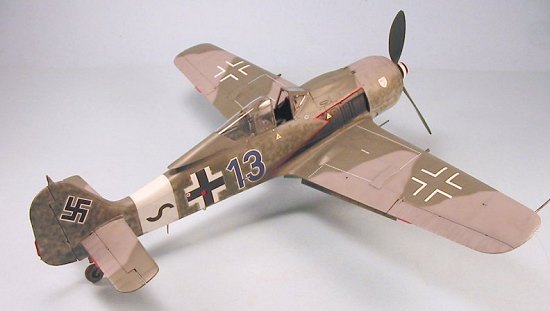 As the
American bomber formations had grown in size and striking power from the
summer of 1943, Reichsmarschall Goering had - after the first
Schweinfurt mission in August 1943 - ordered that, if necessary, fighter
pilots must continue their attack on a bomber formation to the point of
deliberate ramming. This did not become an actual tactic of the
Jagdflieger until Major Hans-Guenther von Kornatzki persuaded OKL
to allow the formation of Sturmstaffel 1, to attempt the
development of deliberate ramming of enemy bombers as a tactic.
As the
American bomber formations had grown in size and striking power from the
summer of 1943, Reichsmarschall Goering had - after the first
Schweinfurt mission in August 1943 - ordered that, if necessary, fighter
pilots must continue their attack on a bomber formation to the point of
deliberate ramming. This did not become an actual tactic of the
Jagdflieger until Major Hans-Guenther von Kornatzki persuaded OKL
to allow the formation of Sturmstaffel 1, to attempt the
development of deliberate ramming of enemy bombers as a tactic.
The unit was formed in late 1943 and attached to I/JG1 at Dortmund in January 1944. The unit’s concept was based on the army’s Sturm detachments, whose mission was to close with the enemy and engage him in hand-to-hand, close-quarter combat. While the unit closed the enemy formation and engaged from the rear, it was actually only in exceptional circumstances and as a last resort that a pilot was expected to ram, and then only if he could bail out before impact. The Sturmstaffel was not the German version of the Kamikaze. Most of the time, if the pilot had closed on a bomber that close, the bomber was usually done for from the 30mm hits. Of pilots who did ram, at least 50 percent were reported to have escaped by parachute uninjured.
Sturmstaffel 1 entered combat on January 11, 1944, when Oberleutnant Zehart scored the unit’s first victory - a B-17. Unteroffizier Willi Maximowitz got his first, a B-24, near Hanover on January 30. The unit saw more successful action during “Big Week” in February, and in the battles over Berlin in early March.
In late April 1944, IV/JG 3, which had recently converted from the Bf-109 to the Fw-190,was selected to take the success of von Kornatzki’s Sturmstaffel 1 to the next level: the unit was to become the first Sturmgruppe. Based at Salzwedel, it was equipped with the Fw-190A-8/R2, specifically produced for the role. The surviving pilots from Sturmstaffel 1 were assigned to the unit to provide a leavening of experienced veterans.
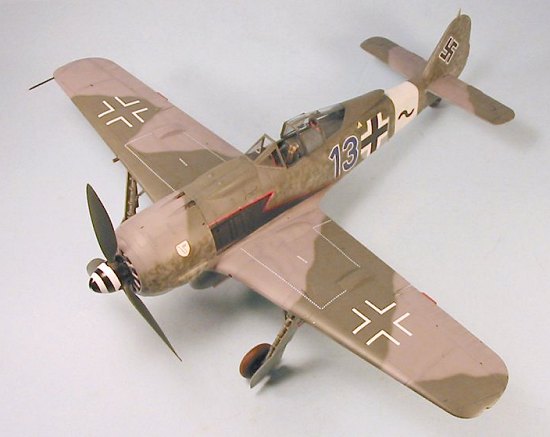 IV/JG
3's most successful mission came on July 7, 1944, when 1,100 heavy
bombers escorted by 750 fighters were sent against synthetic oil
refineries in central Germany. Escorted by two Bf-109 Gruppen
from JG 300, the unit attacked a formation of B-24s that were
temporarily deprived of fighter cover. 28 B-24s were shot down,
including 12 of 18 sent up from the 492nd Bomb Group. Nine
Fw-190s were shot down and five pilots killed; by the standards of the
time, the mission was considered an outstanding success. By early
September 1944, the Fw-190s of the Sturmgruppen were the only
Fw-190s committed to the defense of the Reich, while the other Wurger-equipped
units recuperated from the terrible losses in Normandy that previous
summer.
IV/JG
3's most successful mission came on July 7, 1944, when 1,100 heavy
bombers escorted by 750 fighters were sent against synthetic oil
refineries in central Germany. Escorted by two Bf-109 Gruppen
from JG 300, the unit attacked a formation of B-24s that were
temporarily deprived of fighter cover. 28 B-24s were shot down,
including 12 of 18 sent up from the 492nd Bomb Group. Nine
Fw-190s were shot down and five pilots killed; by the standards of the
time, the mission was considered an outstanding success. By early
September 1944, the Fw-190s of the Sturmgruppen were the only
Fw-190s committed to the defense of the Reich, while the other Wurger-equipped
units recuperated from the terrible losses in Normandy that previous
summer.
JG300, which had been originally formed as a Wilde Sau nightfighter unit converted to the day fighter role in May and June 1944, as the American daylight offensive grew in strength and numbers. II/JG300 converted to the Fw-190A-8/R2 specifically for the heavy attack role, as IV/JG3 had already shown some success in May 1944 against the bombers. The unit would go on to be the leading Sturmgruppe of the Luftwaffe.
Walther Dahl:
Walther Dahl joined the Luftwaffe in 1937, transferring from the Army. Upon completion of flight training, he became in instructor pilot in 1939 and did not go on operations until May 1941 when he transferred to the Geschwaderstab of JG3, in time to participate in Operation Barbarossa, the invasion of the Soviet Union. He transferred to II/JG3 in July and by October had 17 victories. In December 1941, he was transferred to 4.JG3 and went with that unit to Sicily, where he participated in the air war over Malta, claiming two victories. In April 1942 he was transferred to the staff of General Adolf Galland, General der Jagdflieger, where he remained until being posted as Geschwader Adjutant with JG3 on the Eastern Front in August; he shot down four Il-2 Sturmoviks on October 26, 1942, bringing his score to 37.
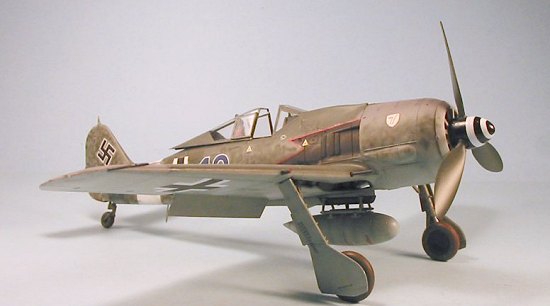 In July
1943 Dahl became Gruppenkommandeur of III/JG3, now based at
Münster for defense against American daylight bombers. Dahl led III./JG3
against the Schweinfurt/Regensburg raid on August 17, but was intercepted
by Spitfires from 222 Squadron; five III./JG3 Bf-109s were shot down and
Dahl himself had to make a belly landing when his Bf-109G-6 suffered
engine failure. He shot down two four-engined bombers on September 6,1943
and two more four-engined bombers and a P-38 February 23, 1944. After
being awarded the Ritterkreuz on March 11 for 67 victories. After
becoming Kommodore of the air fighting development Geschwader in May, he
was appointed Kommodore of JG300 on June 27. Despite successfully
leading JG300 against the Allied bombers through the summer and fall,
Dahl was dismissed from his command by Herman Goering at the end of
November, 1944, following two disastrous meetings where the heavy
Sturmbocks were intercepted by the American fighter escorts with
heavy casualties. Dahl became Inspector of Day Fighters in January 1945,
though he continued to fly combat missions and he was awarded the
Eichenlaub in February 1945 for 92 victories, scoring his 100th
victory at the end of the month. In march 1945 he transitioned to the
Me-262 and flew under the command of Heinz Bär in III/EJG2. On March 27,
he shot down two P-47s and scored his 128th and last victory,
a P-51, on April 26, 1945.
In July
1943 Dahl became Gruppenkommandeur of III/JG3, now based at
Münster for defense against American daylight bombers. Dahl led III./JG3
against the Schweinfurt/Regensburg raid on August 17, but was intercepted
by Spitfires from 222 Squadron; five III./JG3 Bf-109s were shot down and
Dahl himself had to make a belly landing when his Bf-109G-6 suffered
engine failure. He shot down two four-engined bombers on September 6,1943
and two more four-engined bombers and a P-38 February 23, 1944. After
being awarded the Ritterkreuz on March 11 for 67 victories. After
becoming Kommodore of the air fighting development Geschwader in May, he
was appointed Kommodore of JG300 on June 27. Despite successfully
leading JG300 against the Allied bombers through the summer and fall,
Dahl was dismissed from his command by Herman Goering at the end of
November, 1944, following two disastrous meetings where the heavy
Sturmbocks were intercepted by the American fighter escorts with
heavy casualties. Dahl became Inspector of Day Fighters in January 1945,
though he continued to fly combat missions and he was awarded the
Eichenlaub in February 1945 for 92 victories, scoring his 100th
victory at the end of the month. In march 1945 he transitioned to the
Me-262 and flew under the command of Heinz Bär in III/EJG2. On March 27,
he shot down two P-47s and scored his 128th and last victory,
a P-51, on April 26, 1945.
With a total of 36 4-engine bombers to his credit, Walther Dahl was the second-leading Luftwaffe bomber experte. After the war, he became involved with Hans Ulrich Rudel in neo-Nazi political activities and was one of the founders of the NDP in the 1960s. Faced with government opposition, he retired in the 1970s and died in 1985 at age 67. He also wrote a rather lurid account of his wartime experiences, in which he invented the term “Rammjager” for the Sturmgruppen, a word which has made other men who flew that mission grind their teeth for the 40 years since he wrote the book.
|
THE KIT |
 For a look
at what comes in the box, please
visit the preview.
For a look
at what comes in the box, please
visit the preview.
This kit is in my opinion the best radial-engine Fw-190 kit available in any scale. It is well-designed as a kit and accurate as a model; a modeler really has to consciously go out of their way to avoid creating a beautiful model by following the instructions. To me, the only thing the kit needs is a good set of seat belts to improve the cockpit. I recommend the Cutting Edge posable resin seat belts, which result in a very realistic look to the cockpit after they are installed. Fortunately, the plethora of decals available in 1/48 is starting to show up in 1/32 scale, so modelers who want to do more than one of this great kit will have plenty of markings options.
|
CONSTRUCTION |
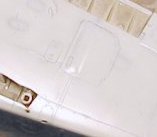 Converting
this kit to the Fw-190A-8/R2 is easy as can be, since it only involves
using the other underwing panel that is not used in the instruction; this
provides the ejection chutes for the 30mm cannon. These underwing panels
are the only difficult part of the kit, since you need to fill in almost
all of the seams, aiming to get a completely smooth surface to the wing.
I have found that filling the seams with cyanoacrylate glue, sanding that
smooth and then going over the seams with Mr. Surfacer will solve the
problem easily.
Converting
this kit to the Fw-190A-8/R2 is easy as can be, since it only involves
using the other underwing panel that is not used in the instruction; this
provides the ejection chutes for the 30mm cannon. These underwing panels
are the only difficult part of the kit, since you need to fill in almost
all of the seams, aiming to get a completely smooth surface to the wing.
I have found that filling the seams with cyanoacrylate glue, sanding that
smooth and then going over the seams with Mr. Surfacer will solve the
problem easily.
I made the Scheuklappen, the armored glass side panels called “blinkers,” using clear plastic cut from some Scotch tape dispensers, cut to shape and then Futured. Operationally, these panels had a tendency to ice up and ruin visibility; by the late summer of 1944, most Sturmgruppen pilots had removed them from their canopies.
For the purists who will wonder what happened to doing a full conversion to R8 standard with the fuselage armor, my decision not to apply any was based on the fact that I can’t tell from the photos if this airplane had the full extra fuselage armor (and I looked hard at both shots) and also didn’t have any drawings that gave me the information for doing the armor.
While most reviewers (me included) have lamented the inclusion of the “wrong” drop tank in this kit - in that it is the least-used tank according to photos - in fact the kit tank is correct for the particular airplane I decided to do, from the available photos. For those who want the other tank, the easiest thing is to swap tanks between the Fw-190 kit and the Bf-109 kit; then you have the tank most seen on each. There are some modifications to be accomplished as to how these tanks fit their racks on the different kits, but that is nothing difficult.
|
COLORS & MARKINGS |
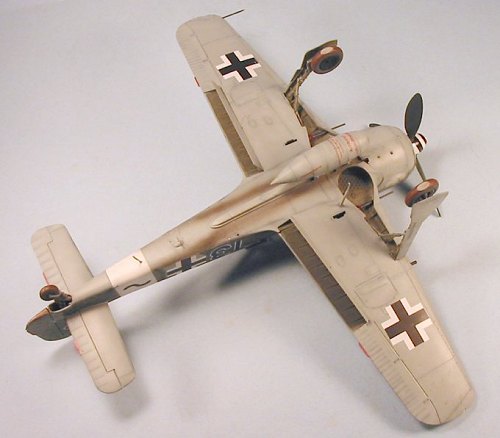 I had the
new Cutting Edge decal sheet which includes an Fw-190A-8/R8 flown by Dahl
when he was Kommodore of JG300, with an interesting B-17-in-a-gunsight
propaganda marking, with his personal insignia of “Blue 13.” However,
the camouflage of the airplane is otherwise undistinguished, and the
airplane is not equipped with the Scheuklappen, which I wanted to
have so that the model would be visually different from other Fw-190s in
my collection.
I had the
new Cutting Edge decal sheet which includes an Fw-190A-8/R8 flown by Dahl
when he was Kommodore of JG300, with an interesting B-17-in-a-gunsight
propaganda marking, with his personal insignia of “Blue 13.” However,
the camouflage of the airplane is otherwise undistinguished, and the
airplane is not equipped with the Scheuklappen, which I wanted to
have so that the model would be visually different from other Fw-190s in
my collection.
So, rather than do the easy model, I decided to venture into the minefield and do an Fw-190A-8/R8 that is very controversial. It is an airplane from IV/JG3, as distinguished by the white Reichsverteidigung stripe and IV Gruppe insignia. It has the Scheuklappen, and has been identified at one time as one of the airplanes flown by Dahl with his “Blue 13" insignia, and at other times as “Black 13,” flown by another pilot of the unit. Luftwaffe Experten like to point out that Dahl did not fly with IV/JG3, being Gruppenkommandeur of III/JG3, and that he was already at JG300 at the time the photos of this airplane were allegedly taken in June 1944.
However, look at the photo just below:
This is the
same airplane as is in the well-known photograph taken from the left
side, which is published (among many other places)
 in Osprey’s
“Fw-190 Aces of the Western Front.” It even looks to have been taken
within minutes of the other photo, since both of them show the airplane
with a dark canvas cover of some sort over the engine cowling and the
same style of drop tank - that cowling is definitely not painted
black (that you can tell for sure one way or the other), as anyone with
vision correctable to 20/20 can see here in this photo. And you can see
the same cover in the other picture, too. What’s particularly important
about this photo is that the guy in the RAF Irvin Jacket at the right of
the picture - is Walther Dahl.
in Osprey’s
“Fw-190 Aces of the Western Front.” It even looks to have been taken
within minutes of the other photo, since both of them show the airplane
with a dark canvas cover of some sort over the engine cowling and the
same style of drop tank - that cowling is definitely not painted
black (that you can tell for sure one way or the other), as anyone with
vision correctable to 20/20 can see here in this photo. And you can see
the same cover in the other picture, too. What’s particularly important
about this photo is that the guy in the RAF Irvin Jacket at the right of
the picture - is Walther Dahl.
This leads one to wonder if the airplane - which has Dahl’s well-known number on it - might actually be his. The picture was obviously not taken in the circumstances that have been described so many times by so many experts, because Dahl is there - wherever and whenever there is.
Can someone please present proof that this airplane was photographed where and when so many say it was? I am aware that Gunter Rall’s Bf-109G-2 “Black 13" is only considered to have been his until relatively recently because of a photo taken of him standing nearby it - and that in fact was it not his. But here is Dahl standing in the immediate vicinity of this airplane and all the experts say he was never in the unit, never there when that airplane was there! This picture certainly forces some re-thinking about what is what.
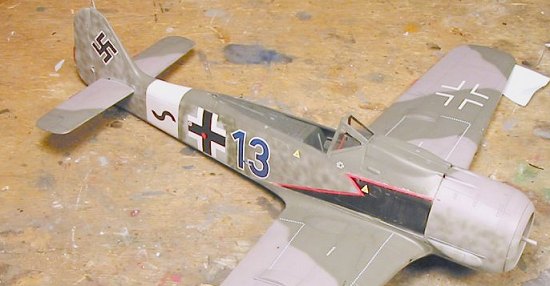 At any rate
- whether or not it is Dahl’s - the airplane seems interesting to me,
since it is obviously one that began life with the standard Fw-190
camouflage, and was later overpainted on the fuselage sides and the
vertical fin and rudder with what looks like a deep mottle of RLM74 and
RLM75.
At any rate
- whether or not it is Dahl’s - the airplane seems interesting to me,
since it is obviously one that began life with the standard Fw-190
camouflage, and was later overpainted on the fuselage sides and the
vertical fin and rudder with what looks like a deep mottle of RLM74 and
RLM75.
Profiles of this airplane have also shown the stylized exhaust scheme as black bordered with white. I disagree, since whatever the color of the border is, it is a different shade of light grey than the white of the national insignia when you look at the left-side photo, and also in this photo above. I suspect it is red (though perhaps it was yellow), since many other IV/JG3 aircraft have been identified as having a red trim to the stylized exhaust.
As to what the color of the engine cowling and what markings might be there is concerned, there is no way of telling from these photos, since the cowling is covered. It could have been black; Willi Maximowitz’s certainly was. I chose to do it as a camouflage with the intensified side dapple, and with the JG3 Geschwader insignia, since other aircraft of the unit are shown with both camouflage painted cowling and the Udet winged “U”.
So there is my reasoning as to why the model is done as it is.
In painting, I started by pre-shading the model along the panel lines, then masking off the exhaust stylization, then painting the white JG3 Reichverteidigung stripe and masking it off and painting the edge of the exhaust, going over that with red, then masking it off too.
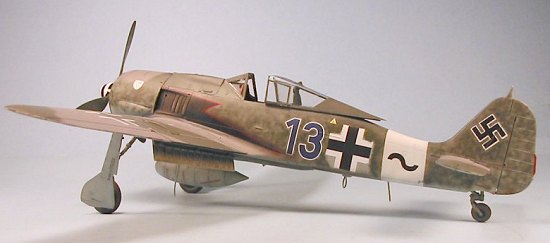 I then
painted the lower surfaces with Gunze Sangyo RLM76 Lichtblau, then
did the upper surfaces in the Fieseler pattern with RLM74 and RLM75, done
with Gunze-Sangyo “German Field Grey” with some blue-grey in it for
RLM74, and Gunze-Sangyo “Medium Sea Grey” for RLM75. I also did a
moderately-heavy mottle with the two colors, 74 over 75.
I then
painted the lower surfaces with Gunze Sangyo RLM76 Lichtblau, then
did the upper surfaces in the Fieseler pattern with RLM74 and RLM75, done
with Gunze-Sangyo “German Field Grey” with some blue-grey in it for
RLM74, and Gunze-Sangyo “Medium Sea Grey” for RLM75. I also did a
moderately-heavy mottle with the two colors, 74 over 75.
When this was dry, I gave the model a coat of Future.
Decals:
I used the Cutting Edge decals, which went down with no problem. Once I looked at the model with the markings on it and compared that with the photos, it was clear I had not done the mottle with sufficient intensity.
When the decals were dry, I washed the model off, then applied intensified RLM74 mottle on the fuselage sides and the vertical fin, as shown in the reference photographs - one should note that the painting around the national insignia on the two sides was slightly different. I thinned the paint 60-40 with rubbing alcohol and tightened the brush down as much as I could to do the over painting; there is some very slight overspray visible on the national insignia and the swastika, which is accurate for what was done on the real thing. When all this was done, I applied the Winged-U insignia on the engine cowling.
|
FINAL CONSTRUCTION |
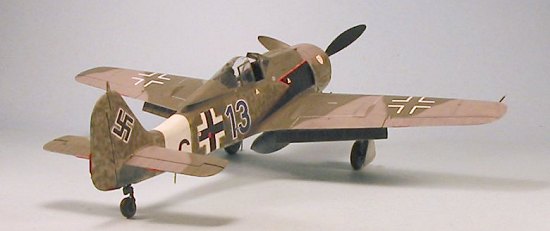 I then
applied a coat of Future to the model after washing it to get rid of
decal residue, then gave it two coats of thinned Dullcote. I then applied
exhaust staining with thinned Tamiya Semi-Gloss Black mixed with a bit of
gloss Red Brown.
I then
applied a coat of Future to the model after washing it to get rid of
decal residue, then gave it two coats of thinned Dullcote. I then applied
exhaust staining with thinned Tamiya Semi-Gloss Black mixed with a bit of
gloss Red Brown.
I unmasked the canopy and attached the Scheuklappen with Micro Krystal Kleer white glue.
I attached the landing gear and the drop tank, and the prop and canopy.
|
CONCLUSIONS |
This is a very distinctive-looking airplane, a perfect subject for the “larger canvas” that a 1/32 scale model provides. Is it one of Walther Dahl’s airplanes? I’m not saying “yes,” but with that photo of him standing near it, I don’t think any other “expert” can say “no” definitively.
Kit courtesy of my wallet; decals and seat belts courtesy of Meteor Productions.
|
REFERENCES |
(There is an excellent Classic Publications book on Sturmstaffel 1 and it is highly recommended for those interested in this fascinating unit.
Another good reference on the subject is Scale Aircraft Modeling, March 2001 with Neil Page's article on Sturmstaffel. Ed.)
June 2004
If you would like your product reviewed fairly and quickly by a site that has over 250,000 visitors a month, please contact me or see other details in the Note to Contributors.